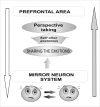How we empathize with others: a neurobiological perspective
- PMID: 21169921
- PMCID: PMC3524680
- DOI: 10.12659/msm.881324
How we empathize with others: a neurobiological perspective
Abstract
Empathy allows us to internally simulate the affective and cognitive mental states of others. Neurobiological studies suggest that empathy is a complex phenomenon, which can be described using a model that includes 2 modes of processing: bottom-up and top-down. Bottom-up neural processing is achieved via the mirroring representation systems that play a key role in the direct sharing of the emotional states of others. Top-down processing, known as cognitive perspective-taking or theory of mind, where the feelings of others are fully imagined and understood, is based on control and inhibition mechanisms. Available evidence indicates that empathic brain responses are likely to be influenced by several different modulating factors.
Figures



References
-
- Eisenberg N. Emotion, regulation, and moral development. Annu Rev Psychol. 2000;51:665–97. - PubMed
-
- Hoffman ML. Empathy and moral development. Gdańsk: GWP; 2006.
-
- Decety J, Jackson PL. The functional architecture of human empathy. Behav Cogn Neurosci Rev. 2004;3:71–100. - PubMed
-
- Preston SD, de Waal FB. Empathy: Its ultimate and proximate bases. Behav Brain Sci. 2002;25:1–20. - PubMed
-
- Rizzolatti G, Fadiga L, Gallese V, et al. Premotor cortex and the recognition of motor actions. Brain Res Cogn Brain Res. 1996;3:131–41. - PubMed
Publication types
MeSH terms
LinkOut - more resources
Full Text Sources

